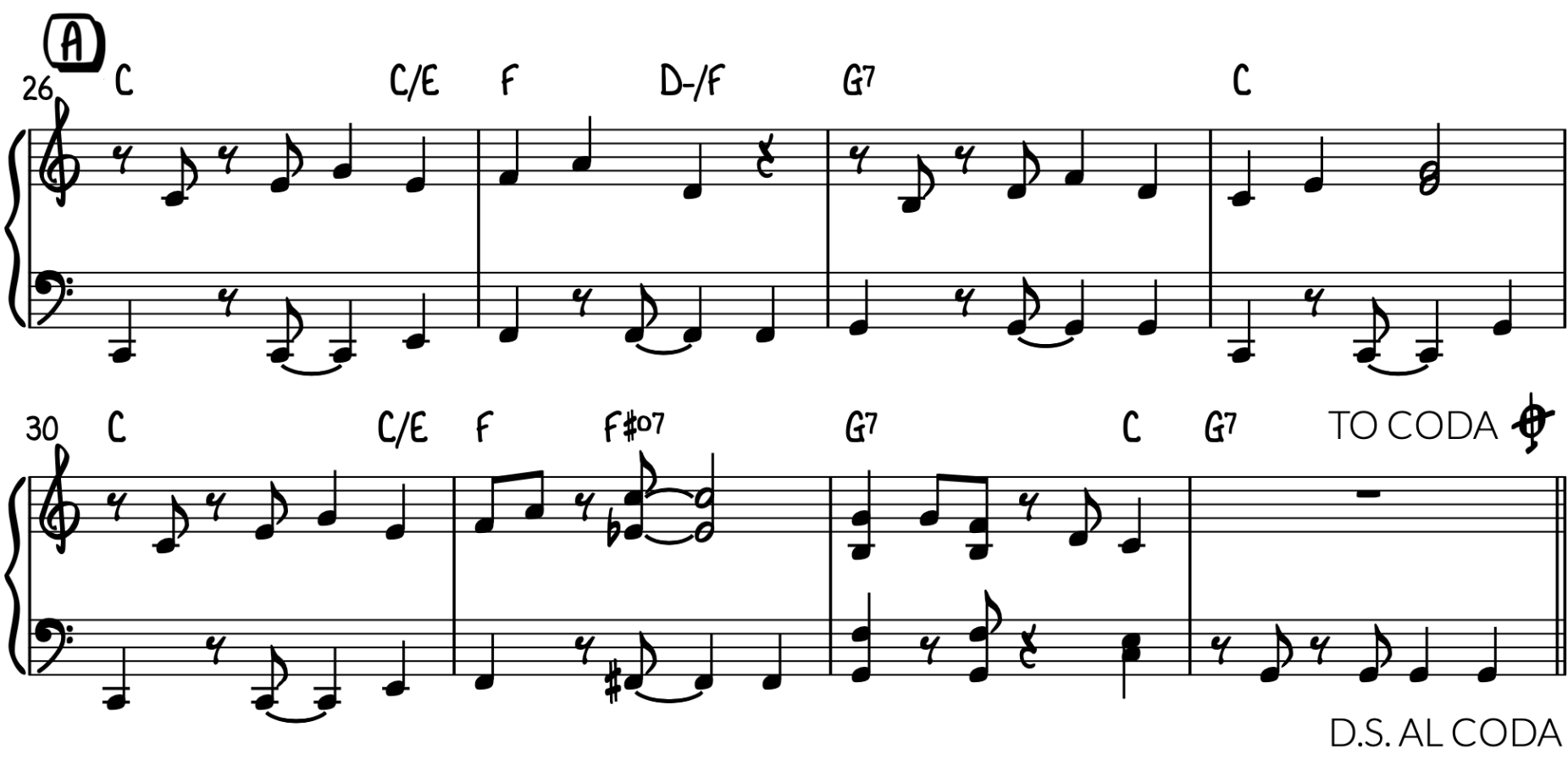How to Play Calypso Jazz Piano
Learning Focus
Music Style
Free Lessons
Get free weekly lessons, practice tips, and downloadable resources to your inbox!
Have you ever wanted to play Caribbean calypso jazz songs on piano like those recorded by Sonny Rollins, Monty Alexander and Kenny Barron? Well, in today’s Quick Tip, How to Play Calypso Jazz Piano, John Proulx teaches jazz students of all levels essential Caribbean jazz piano techniques along with an original calypso song. You’ll learn:
- Intro to Caribbean Calypso Music
- Calypso Jazz Piano Techniques
- Harmonic Characteristics of Calypso Music
- Application: Play a Calypso Jazz Arrangement
Intro to Caribbean Calypso Music
Calypso music is a style of Caribbean folk song that originated in Trinidad and Tobago in the early 19th century, which evolved on sugar plantations from the kaiso music of West African slaves. Early calypso music was usually sung in a French creole by a griot (later called a calypsonian), who was both a singer-poet and an oral historian. By the early 20th century, Calypso music had spread throughout the West Indies and the Americas. Since the mid-20th century, calypso music has been closely aligned with the sound of steel drums (aka “steel pans”), which also originated in Trinidad and Tobago.¹
American singer and actor Harry Belafonte played a significant role in popularizing calypso music worldwide during the 1950s and 1960s and was even dubbed the “King of Calypso.”² In popular culture, calypso music has occasionally risen in public consciousness in junction with its inclusion in films, such as Belafonte’s recording of “Day-O (The Banana Boat Song)” in Beetlejuice (1988) and “Under the Sea” in Disney’s The Little Mermaid (1989).
What is calypso jazz music?
Calypso jazz (aka Caribbean jazz) emerged in the late 1950s and early 1960s as a festive blend of Caribbean folk melodies and rhythms with traditional jazz instruments and the spirit of improvisation. Prominent jazz musicians who composed and recorded calypso jazz compositions include Sonny Rollins, Dizzy Gillespie, Kenny Barron, Monty Alexander, Wynton Kelly and Randy Weston.³
The following jazz compositions are representative of the distinctive Caribbean flavor of calypso jazz:
Monty Alexander
“Sly Mongoose” (2014)
Kenny Barron
“Fungii Mama” (1991)
Sonny Rollins
“St. Thomas” (1956)
The following song list contains additional calypso jazz tunes as recorded by jazz giants:
- “And Then She Stopped” – Dizzy Gillespie
- “Angelica” (aka “Purple Gazelle”) – Ellington/Coltrane
- “Blue Calypso” – John Coltrane
- “Brown Skin Girl” – Sonny Rollins
- “Calypso” – Kenny Barron Trio
- “Capricious” – Gerry Mulligan
- “Carnival” – Randy Weston
- “Don’t Stop the Carnival” – Sonny Rollins
- “Duke of Iron” – Sonny Rollins
- “Eclypso” – Tommy Flanagan & John Coltrane
- “The Everywhere Calypso” – Sonny Rollins
- “Global Warming” – Sonny Rollins
- “Jamento” – Monty Alexander
- “Little Tracy” – Wynton Kelly
- “Hold ‘Em Joe” – Sonny Rollins
- “Poor Joe” – Dizzy Gillespie
Now that you have a good idea of what calypso jazz sounds like, let’s learn more about the musical characteristics of this unique Caribbean jazz tradition.
Calypso Jazz Piano Techniques
In many respects, Calypso jazz is a fairly accessible sub-genre of jazz music, making it suitable for all playing levels from beginners to professionals. This is mainly due to the fact that calypso tunes tend to have fewer chord changes overall and are composed primarily of diatonic chords.
In this section of today’s lesson, you’ll learn essential piano techniques commonly found in Caribbean jazz music. All of the examples in this lesson are excerpted from the lesson sheet PDF that is included with today’s Quick Tip. If you’re already a PWJ member, then you can download the PDF and backing track from the bottom of this page after logging in with your membership. In addition, PWJ members can also transpose this lesson to any key using our Smart Sheet Music.
Left Hand Techniques for Calypso Jazz
Let’s begin by examining two different approaches that a pianist can use in their left hand when playing calypso jazz music:
- Two-Feel Bass Line
- Syncopated Bass Line
Two-Feel Bass Line
A two-feel bass line is primarily structured around half notes, which emphasize the strong beats in each measure—that is, beats one and three. A two-feel almost always features the root of the chord on beat one. Then, on beat three, you can repeat the root, or play another chord tone, such as the 3rd or 5th.
Here is an example of a simple two-feel bass line that uses half notes over a calypso-style drum groove:

As you repeat this bass line, you’ll probably want to experiment with some subtle variations, such as octave displacement. For example, you can change the contour of the bass line play playing the initial C an octave higher. Or, you could play the G’s in measure 3 in different octaves. Of course, two-feel bass lines are not unique to calypso music. In fact, they also commonly occur in jazz swing music. To discover additional tips on this topic, check out our Quick Tip on How to Play a Two-Feel Bass Line on Piano (Beg–Adv).
Syncopated Bass Line
A second left hand approach for calypso jazz music is to play a syncopated bass line. For example, the following bass line combines notes that occur on beat one, the “and of two” and beat four, the creating an infectious, danceable groove.

Next, let’s turn our attention to the right hand.
Right Hand Technique for Calypso Jazz
Right hand piano techniques for calypso music often vary depending on whether a pianist is performing the melody, soloing or accompanying. For now, we’ll examine a common right hand accompaniment rhythm known as on-off chords. This syncopated rhythmic figure features two chords per bar, one of which is placed “on” the beat (beat one in particular) and another which is placed “off” the beat (on the “and of two” to be specific).
In general, on-off chords should also make use of some chord inversions so that the chord changes have smooth transitions with good voice leading. For instance, here is an example of on-off chords in the right hand over a calypso-style drum groove:
On-Off Chords

Next, let’s consider a two-handed technique that pianists often use in calypso jazz music.
Two-Handed Technique for Calypso Jazz
So far, we’ve examined separate calypso piano techniques for each hand. However, jazz pianists also sometimes use a two-handed approach, especially when harmonizing a calypso melody.
Harmonized Melody
Calypso jazz pianists frequently employ the sound of a harmonized melody to mimic the bright overtones of steel drums. Modern steel drums are crafted in such a manner that each fundamental pitch is carefully tuned to contain several partials (aka harmonics or overtones). These subtle, sympathetic vibrations resonate above the fundamental pitch at a softer volume, yet they still contribute to the overall buoyant tone color of the instrument.
Most steel drums are tuned to include the 2nd partial (up an octave) and the 3rd partial (up an octave + a perfect 5th). More expensive instruments may include the 4th partial (up two octaves), the 5th partial (up two octaves + a major 3rd) and beyond. Check out this video to see and hear a short demo on steel drum tuning.
In the following example, we have a typical calypso melody that is composed from arpeggios of the primary chords in C major. However, since each hand begins on a different inversion, we wind up with a melody that is primarily harmonized with 6ths intervals.

In the next section, we’ll explore some of the different types of chord progressions found in calypso jazz music.
Harmonic Characteristics of Calypso Music
Calypso vocal music is frequently characterized by diatonic chords. In particular, the primary triads in a major key are most common, which include the Ⅰ, Ⅳ and Ⅴ chords. For example, a typical calypso chord progression in C major would be C major → F major → G major → C major, or Ⅰ→Ⅳ→Ⅴ→Ⅰ.
Representative Progression for Calypso Music
The following example demonstrates a Ⅰ→Ⅳ→Ⅴ→Ⅰ chord progression in C major that represents common harmonic movement in calypso vocal music.

Representative Progression for Calypso Jazz
Calypso jazz maintains strong continuity with traditional Caribbean folk music in many aspects. However, the chord progressions found in calypso jazz generally include more complex jazz harmonies. For instance, the following chord progression includes diatonic chords with the addition of passing chords that are so commonplace in jazz repertoire. In fact, this progression comes from measures 5–8 of the common jazz form known as rhythm changes.

So far, we’ve learned a lot about calypso music in general and calypso jazz in particular. In the next section, we’ll put all of these techniques together as we play a complete calypso jazz piano song arrangement.
Application: Play a Calypso Jazz Arrangement
Are you ready to have some fun playing a full-length calypso jazz piano arrangement? This section features John Proulx’s original calypso jazz tune entitled “Jamaican Me Dance.” This punny title is a tribute to Jamaican American jazz pianist Monty Alexander, whose playing style frequently blends his dual Caribbean and American musical heritage. “Jamaican Me Dance” is written in AABA form with the addition of an intro and a coda. Let’s examine the tune one section at a time.
Introduction
The intro to “Jamaican Me Dance” features on-off chords and a syncopated bass line over a simple diatonic chord progression in C major.
Initial A Sections
The initial A sections of “Jamaican Me Dance” contain a calypso melody in the right hand over a syncopated bass line. The chords are mostly straightforward and diatonic, except for the F♯º⁷ passing chord in measure 14. Coordinating the rhythms between the hands in this section can be a bit tricky. However, you can slow down the video demonstration by clicking on the gear icon (⛭) in the lower right-hand corner of the video frame.
B Section
The B section of “Jamaican Me Dance” includes more prominent use of passing chords, as well as some intentional breaks which are reminiscent of the bridge section of Sonny Rollin’s calypso jazz standard “St. Thomas.”
Final A Section
After the B section, “Jamaican Me Dance” features another eight-measure reprise of the A section. This is followed by a D.S. al Coda instruction, which essentially calls for a repeat of the entire AABA form. Keep in mind, on the final pass through the final A section, you’ll proceed directly to the coda, which functions as a tag ending.
Ending
The coda of “Jamaican Me Dance” follows on the heels of the final A section and tags the last 4-bar phrase two times before coming to a close.
Conclusion
Congratulations, you’ve completed today’s lesson on How to Play Calypso Jazz Piano. Now it’s time to hit the practice room, feel the rhythms and find your groove!
If you enjoyed today’s lesson, be sure to check out the following resources:
Courses
Latin Jazz Learning Tracks
Would you like to comment on this lesson?
Visit this Quick Tip on YouTube
Thanks for learning with us today! We’ll see you next time.
¹ “Calypso (music).” Britannica.com, 17 Feb. 2025.
² Young, Kevin. “Harry Belafonte, Actor and Activist.” National Museum of African American History and Culture, 31 Jan. 2024.
³ “Syncopating Rhythms: Jazz and Caribbean Culture” Jazzstudiesonline.org, 2025.
 Writer
Writer
Michael LaDisa
Michael LaDisa graduated from the University of North Texas with a major in Music Theory & Composition. He lives in Chicago where he operates a private teaching studio and performs regularly as a solo pianist. His educational work with students has been featured on WGN-TV Evening News, Fox 32 Good Day,...
More Free Lessons
Want to learn how to serenade your soulmate with beautiful, romantic piano improvisation? Let your fingers do the talking with these 4 steps!
Struggling to play blues piano with skill and sensitivity? Master these blues piano left hand patterns to take your feel to the next level!
Explore the methods and mindset needed to comp on piano in the swing style with this complete guide to jazz piano comping for all levels.
Looking for downloads?
Subscribe to a membership plan for full access to this Quick Tip's sheet music and backing tracks!
Join Us
Get instant access to this Quick Tip and other member features with a PWJ membership!
Guided Learning Tracks
View guided learning tracks for all music styles and skill levels
Progress Tracking
Complete lessons and courses as you track your learning progress
Downloadable Resources
Download Sheet Music and Backing Tracks
Community Forums
Engage with other PWJ members in our member-only community forums
Become a better piano player today. Try us out completely free for 14 days!









